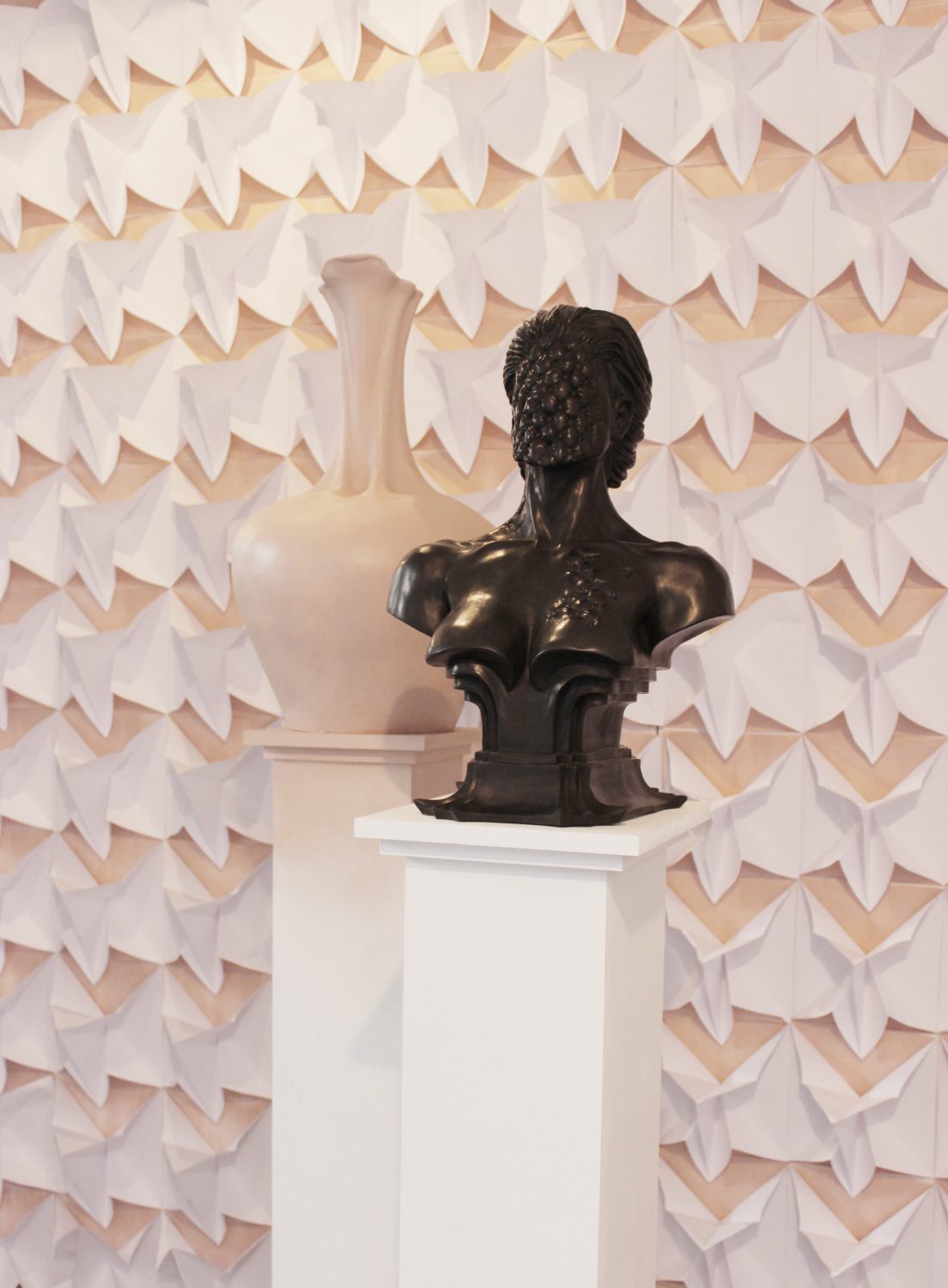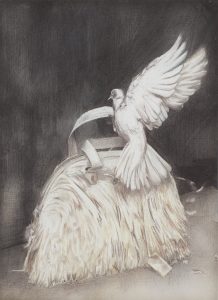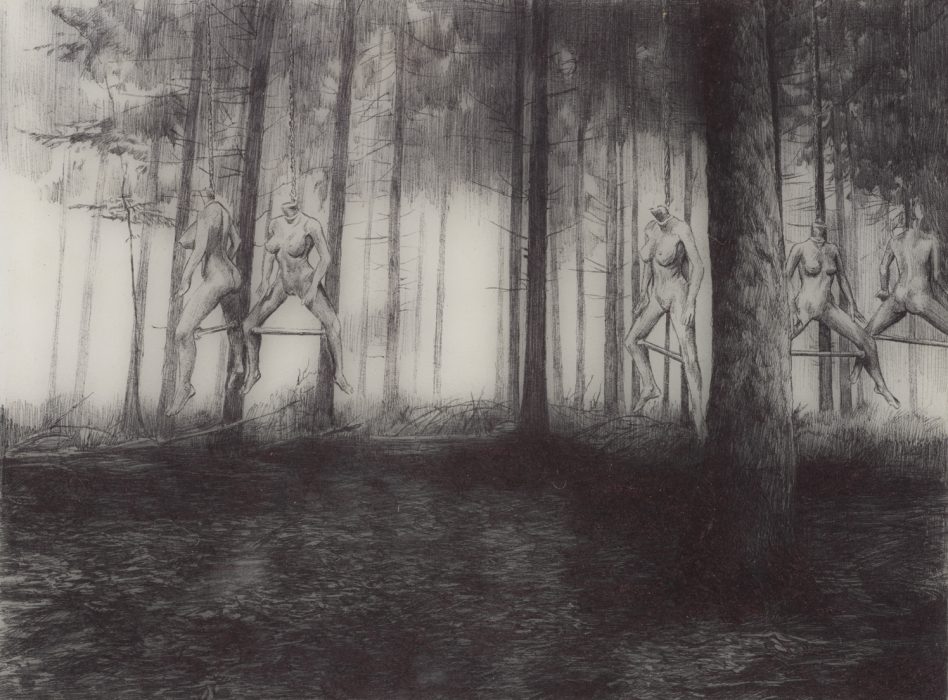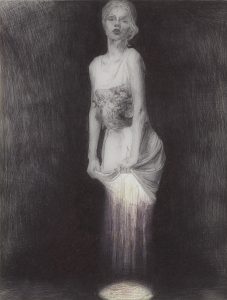‘A never-ending race towards the Ultimate’, an interview with Mathieu V. Staelens
An interview with Mathieu V. Staelens by Wouter van de Koot: ‘A never-ending race towards the Ultimate’
I met Mathieu V. Staelens about eight years ago, when we were both on our way to deliver our work to a drawing contest. We got to talking and I was amused by his swagger and his positive arrogant attitude towards his work. When I saw his drawings later on, I could not help but to add a great deal of respect (and some jealousy) to that. Today we’re on the verge of our first collaboration, with the exhibition ‘Setting the Scene’. An excellent time to ask Mr. Staelens some questions.
We are sitting in his spacious, stylish living room, some soft music playing in the background. This brings me right to my first question.
‘It’s about the temptation of the viewer’
Is music an influence in your work?
Actually Yes, rhythms, titles, and above all the atmosphere a piece of music evokes. I hear or see something, and a picture arises in my head. A title, or a piece of text, can literally give rise to a new work, or help in the creative process.
Is there a certain record which is the perfect soundtrack to your work?
No, I have a very eclectic taste in music. I like to constantly switch from one atmosphere to the other. In the finishing phase of a painting, where I have to be very precise, I often put on classical music. It makes me feel at ease, and brings me closer to myself. I wouldn’t want to live without music.
You started out as a painter, but you dedicated yourself to making sculptures and drawings for the last five years. So, while I think you’re a painter at heart, the emphasis in your use of medium is clearly shifting. Can you explain that?
Yes, in the last few paintings that I made, the figures already became very sculptural. So I have taken the step to actually turn them into sculptures. It also gave the advantage to be able to put even more emphasis on the materiality. The tactility of the material is very important to me, you see? You have a certain material, your plaster or paint, but you can, for example, make it look like fur, skin, hair, dust, … This gives the work a sensual quality, which is wonderful!
I think your sculptures have a certain frontal quality about them. They are often busts, or bust-like shapes, which you would view from a frontal position. You don’t necessarily want to walk around them, and in that sense they retain a certain two dimensionality. How conscious is that?
That mainly has to do with the fact that they derive from two-dimensional images. I’m still a painter aren’t I… It means I have to fill in the other angles myself. I find it fascinating that it forces me to let go of the image I had foreseen, and find other solutions.
What’s the ideal way to install your sculptures?
That’s going to be exciting, because I haven’t done it a lot yet (laughs). I love to take into account the first view that the spectators have. That has to be right. That first look has to have the most impact. It’s about the temptation of the viewer, Yes, I want to make him or her fall in love with my work. My images have a certain fetish-component. Elements I use in the sculptures, such as the studs, pearls, or a heavy blow dried Hollywood hairstyle, already bear this in them. Take that Hollywood hairdo for example: destructively heated curling irons are used to sculpt the poor starlet’s hair into submission. That form of beauty in which destruction is part of the process of creation excites me beyond measure. In my work ‘ Pragmatism Holds no Dream’ I sacrifice a beautiful face for a studded surface. In that sense, my fascination with fetishism is more anthropological in nature. The sexual component is secondary.
‘I try to banish all morality from my life’
Is your love for the ‘glimmering’ side of existence something you have inherited from childhood?
I believe so, Yes, my mother was a fashion designer in the 1980s. A lot of Bling Bling, high shoulder pads, everything was completely over the top. That is certainly one of the influences. A second factor is that I grew up in the seaside resort of Ostend. I grew up in a body culture. I saw a lot of naked people, bronzed women, marinated in Sun oil. This fleshiness was opposite to what I saw in the fashion magazines in my mother’s boutique. Those two sometimes complete clashed, and along with some other anecdotes from my life, ensured that I make what I make today.
Tell me one of those, please.
Gee, I’ll tell you the one that had the biggest impact. I was about eight years old and attended boarding school. It was a school where designer clothes were huge propagated amongst the kids. I did have a certain fashion consciousness, but my mother could not afford to buy me those designer clothes. Because of that I was bullied for months on end. At first I didn’t let it get to me, but at some point it did start to hurt me. I went to my father then, my parents are divorced, and asked him to buy those clothes for me. The next Monday I went to school feeling so proud! But guess what happened? They started to bully me again. I remember being very angry with myself then. They forced me to follow their morals and when I did, I was still being rejected. That evening I tore up all those new, expensive clothes, and went back to school in them the next day, like a punk. Everyone was shocked and from then on I always created my own style. That attitude is still present in my work. At its core is this question: ‘which moral standard is being put to work to affect the people and their surroundings, and to what extent can you step outside of that system and release yourself from it?’
Can you tell me something about the source of your images?
At first I mostly used advertising material, everything that can be called persuasive imagery. Footage meant to persuade, political stuff too. Overall my work centres on the same set of questions about power, morality and identity. Over the years, this has evolved towards the construction of identity. I ask myself what use a certain kind of power is, related to things that I have been always familiar with, such as fashion. Something that has always disturbed me in modern society is the way people are manipulated into their identity, without being responsible for it.
Is that something which you pay attention to when you meet new people or when you form a relationship?
Yes, very much so. I am interested in someone’s background and the context from which he or she thinks. And then I like to rattle their cages too. In the end, and that is very personal, I try to ban all morality from my life. I want ethics to be my sole guide. A certain shamelessness does help (winks). With morality I mean something that is geographically and culturally defined. Eating dogs for instance. We believe that that’s a terrible thing to do, when in China it’s not a problem at all. In turn, in Japan people find it unheard of that we eat rabbits, because they think rabbits are way too cute, and see them as domestic animals only. Those things are culturally determined, and not universal. Ethics only count if they are valid for the entire world, otherwise they don’t.
Are those ideas fruitful for your work?
Yes, eventually. I want my images to indicate that there is a morality at work which is not necessarily visible but may still affect the way something is viewed and understood. The strongest manifestation of this can be found in the world of glamour and fashion, I think.
I can see notions of decadence and the emptiness of a particular kind of existence in your work, leaning towards the absurd. Would you agree with that?
Yes, the human identity used to lie in the soul, in the content, in the immaterial part of a human being. I think this notion has shifted in our society. More and more, identity coincides with the physical body. So much of it becomes absurd sometimes.
Do you really think this is very different today, compared to, say, the eighteenth century?
Yes, and then I refer to the sociologist Rudi Laermans, who has written about the object awareness. Something which apparently manifests itself since the turn of the 19th century, and is linked to the rise of the consumer society. Since then, people, and it started with the male view on women, can really see themselves as an object, regardless of their actual person. It’s truly a doubling of consciousness. The object you are is being shaped after the projection of the person you want to be. I’m reading a book, ‘The Glamour System’ by Stephen Gundle, partly about the history of glamour, which tells you that the so called glamorous women completely restyled their whole being, as if life was a total performance. How they looked, moved, everything! Emotions are being shown in a rehearsed way, even by ordinary people. They watch movies, TV-series, or anything else they admire, and copy the behaviour they see.
Is the female image in the Western visual culture something that inspires you?
Oh, enormously! Actually in all visual cultures globally. And my inspiration orginates from
Are the women in your work ideal women?
No, they are not ideal women to me, although they are based on ideal types. And I won’t deny that I put my personal preferences in there sometimes, to fill a gap.
Would you like to fall in love with the women you create?
Well, I don’t like quiet women, so I doubt it very much (laughs).
‘A never-ending race towards the Ultimate’
Many of your drawings are miniatures. Would you like to relate to, for example, medieval art?
No, again it’s about the fetishist character they have. When I first made such a drawing I was so surprised by the compact feel it had. It’s like a beautiful small gem. There’s something magical to it!
If you’re talking, your thoughts are often quite comprehensive, yet your work is very clear. How do you get to a clear picture from your abstract and philosophical thought process?
I like to compare it to a love affair. You slowly learn to understand each other, and you go for it, in blind confidence. Then suddenly there is something new, something unknown (negative or positive), and you take a step back, observe and analyse again. My work is like that too. I’m philosophizing, analysing, thinking. Then life intrudes because I have to go to work or take a shower or something, and then it happens. Suddenly the ideas leap forward, out of the blue! So many ideas, more than I can ever perform!
There is one drawing in the exhibition which you worked on for three years, can you describe it for me?
Yes, we see a young woman sitting in a black marbled bathroom. She gazes at the spectator and looks like she’s waiting for something. It’s a bit bizarre, because she has all of her clothes on, in the bathroom, as if she is ready to leave.
What kept fascinating you, that you have worked on it for so long?
That marble. I had a technical fascination to get that marble onto the sheet, those fine twisting lines.
Weren’t you afraid to fail at some point?
Yes, every time I went to work on it I had to be on the utmost top of my ability. Sometimes I could not work on it for weeks. These works are very precarious, you can’t erase anything, so a wrong line is not an option.
A real monks work.
It certainly has something meditative. I can really lose myself in it. And all the while there are so many things going on in the background of my consciousness, that is a truly wonderful feeling!
Have you ever had a phase in which you couldn’t evoke that spirit?
No, not really, but I’ve had to learn a lot of discipline. I realized very quickly that one should really study for the type of work that I want to make. You have to put in a lot of hours. The more concentration, the more progress. When I started I forced myself to paint, every single day for five years on end. I made a lot of monstrous things, but I just had to do it. Now I can no longer do without it. I feel horrible if I don’t work.
The exhibition that we’re going to make is called ‘ Setting the Scene ‘. What does that title mean to you?
I see the set-up of a photo shoot, and the construction of a certain atmosphere. And it also has something pleasantly arrogant about it. Hey, you say unequivocally, there is something amazing going on here, something that will change the status quo. ‘Setting the Scene’ is the beginning of a never-ending race towards the Ultimate.




2 Comments
Join the discussion and tell us your opinion.
I really like your blog.. very nice colors & theme. Amelie Jameson Jon
Very nice blog post. I absolutely love this website. Stick with it! Darcey Sloane Shelman